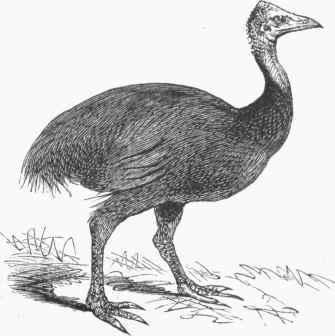Mooruk
Description
This section is from "The American Cyclopaedia", by George Ripley And Charles A. Dana. Also available from Amazon: The New American Cyclopędia. 16 volumes complete..
Mooruk
Mooruk, the native name of a species of struthious bird, discovered in 1857 in the island of New Britain, and named by Mr. John Gould casuarius Bennetti, in honor of Dr. George Bennett of Sydney, N S. W., who first brought it to the notice of the scientific world. The height of the bird when standing erect is 5 ft., of which the neck is 2 ft.; the color rufous mixed with black on the back, and raven black about the neck and breast; the loose wavy skin of the neck is iridescent, with tints of bluish purple, pink, and green; the feet and legs are large and strong, pale ash-colored, the claw of the inner toe being nearly three times as long as the others; there is a horny plate on the top of the head, resembling pearl covered with black lead; the bill is narrower, longer, and more curved than in the emu, somewhat like that of a rail, with a black leathery cere at the base, and a small tuft of black hair-like feathers behind the plate, continued here and there over the neck; the wings are rudimentary. Living specimens have been exhibited at the London zoological gardens.
It seems to form the link between the emu and the cassowary, resembling the former in its bearing and gait; it also resembles the kiwi-kiwi (apteryx) in the style of its motions and attitudes; it is tame and familiar in captivity, and when pleased dances about its place of confinement; it will thrive on boiled potatoes, with occasionally a little meat; it emits a peculiar whistling chirping sound, and some louder notes resembling the name given it by the natives; it is shy, difficult to approach, and still more difficult to pursue on account of its speed in running through the thick brush and its extraordinary power of leaping; it has all the inquisitiveness of the domesticated fowls. The eggs are of about the same size and form as those of the common cassowary, having in most cases thick tubercu-lated shells; they vary from 13 to 14 in. in circumference in the longest diameter, and from 11 to 11 1/2 in the widest; the color is pale olive green, with darker olive tubercles; sometimes they are smooth and without spots. - Another struthious bird is the C. australis (Wall), discovered in the Cape York district of Australia in 1854. It is about the same size as the mooruk; the head is without feathers, covered with a bluish skin, and has a bright red protuberance or helmet; the skin of the neck has six or eight round fleshy balls of blue and scarlet; the body is thickly covered with dark brown wiry feathers; the wings are mere rudiments.
The flesh was eaten by its captors, and was said to be delicious. It is stronger and heavier than the emu, very wary, and not easily killed except with the rifle.

Mooruk (Casuarius Bennetti).
Continue to:


